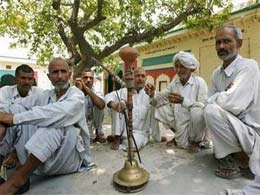The constitutional (73rd amendment) A ct was passed in 1992 by the Narasimha Rao government came into force on April 24 1993.it was meant to provide constitutional sanction to establish “democracy at grassroots level as it is at the state level or national level”
its main feature are:-
- the decentralization of central government into the gram Sabah is the foundation of the panchyati raj system
- A three -tier system at village level-gram Sabah, intermediate level-block(panchyati samati),
- and at district level zilla parishad.
- not less than 1/3 seats of members and office at every level should be reserved for women.
- reservation for weaker/backward caste should be reserved at all levels in accordance to their population in that level
- the election commission exercises direct or indirect control over the bodies of the panchyat for the smooth running of elections which should happen in an interval of 5 years & suggest measures to strengthen the finances of the panchyat.
- to promote bottom up planning the district planning commission has been given constitutional status.
- A list of 29 items has been given to the panchyat A/C to which they are required to play effective role in implementation of these items and those related to it.
the 73rd amendment thus clearly adds to the powers of the panchyat increasing its efficiency. To better understand its impact let’s take an e.g. of a village in Bihar where we can see it an effect in a duration of 6 years.
Bihar is the 12th largest state in terms of geography and 3rd largest in population, among which 58% of the population is below 25, which is the highest proposition in India.
Bihar has 9 divisions 38 districts, 101 sub divisions, 534 locks & 8463, panchyat . here we have taken Nalanda district is one of the 38 district of Bihar. Bihar Sharif is the administrative headquarter of the district it is currently part of the red corridor.
Before the 73rd amendment the participation of women in the gram Sabah was next to nil, if we look at the numbers 66% of the members of the panchyat were male were as only 34% were women, in which 43% of the participants were 41-50 years of age, the minimum age of participation being 30+ at that time religion also played a major role it was seen that the maximum participation was from the Christian community having minimum difference in sex ratio in comparison to Hindu or Muslim
caste background also played a significant role in participation, though the population of backward and scheduled caste was high their participation in the panchyat was not that visible.
thus the 73rd amendment act aided to these problems the participation of women rose to 66% from 34% and with the reservation for SC,ST & OBC gave way for their development .
If you want me to tell you what a nation is like……….. tell me the position of women in that country
–Jawaharlal Nehru first prime minister of India





5 Comments. Leave new
informative and nicely written 🙂
Good work!
The 73rd amendment is actually a very giant stride in development of Indian village governance. It has become much more organised in last 20 years.
Good work.. great effort!!
Some consider it to be the most important amendment in the history of the Indian constitution